
Trade promotion management software: You need it if you want to run promos that top sales
Summarize:
Effective trade promotion management (TPM) software helps retailers, manufacturers, and distributors manage three key processes in one place:
- Planning: Understanding things like which suppliers to work with to increase sales or which promotions to run on specific products to boost sales.
- Execution: Creating, managing, deleting, and modifying product promotions.
- Optimization: Using data analysis and forecasting tools to identify which promotions provide the best return and optimize budget management for future promotional strategies.
How to get trade promotion optimization right to meet (and top) your sales targets
Read the articleYou may have already explored many trade promotion management solutions or just started your search to improve your promo campaigns. Or you might just be beginning to learn about trade promotion management, overall. Either way, this article will help you:
- understand whether your business should get a TPM software
- learn why organized TPM is key to increasing revenue
- discover one TPM tool that fits five different business needs
Do you need a trade promotion management system? Find out with expert checklist
Trade promotion management software offers visibility into critical areas such as upfront promotion planning, forecasting, and financial controls. While this sounds promising, how do you know if investing in such a system will solve your unique business objectives? Our checklist can help you find out.
We talked to representatives from consumer goods companies to understand the real challenges they face with trade promotion management. Together, we identified common problems and transformed them into a checklist — it’ll help you determine if a TPMS is a right fit for your business:

#1. Promotion scheduling chaos: You struggle to keep all of your trade promotion efforts organized across multiple retail partners and brands. Lack of visibility leads to constant scheduling conflicts, missed opportunities, and scrambling to put out fires.
#2. Inaccurate forecasting: Right now, projecting how your trade promotions will actually perform is pretty much a guessing game. You can’t properly analyze past data, spot trends, and build forecasts based on facts. So estimating real sales uplift and ROI is usually way off base.
#3. Blindspots in performance tracking: The second a promotion goes live, you’re kind of flying blind on how it’s actually doing in the market. You’re forced to rely on lagging data updates. This makes it difficult to optimize and fix underperforming trade promotions before it’s too late — before the underperforming promotion has already drained your budget with little impact.
#4. Messy financials: Calculating projected promotion costs and modeling potential ROI is an absolute mess of error-prone spreadsheets and assumptions. You struggle to accurately predict and control trade spend from the very start.
#5. Uncontrolled promotion overspending: Trade promotions eat up a massive chunk of your total budget, but you have zero centralized way to track and manage that spend as it happens. This makes it pretty much impossible to avoid excessive trade spending.
Checked off any of these problems? Trade promotion management software could be the answer to your challenges.
See how initial challenges turn to strategic advantages
Discover how a food manufacturer and retailer cut costs and manual work on their trade promotions.
Show me howA TPMS provides a centralized solution for promotion management. It streamlines processes, improves visibility into key metrics, and effectively addresses inefficiencies. The next section explores what an efficient TPMS looks like and how it can deliver a strong return on investment for your organization.
What makes an efficient trade promotion management system?

An efficient TPMS drives bottom-line savings and top-line growth:
→ In the short term, a TPMS provides an all-in-one solution to persistent challenges and inefficiencies in planning and performing promotions, such as lots of manual work in spreadsheets, budgeting mess, poor data visibility, and more.
→ In the long term, a TPMS should help you meet (and top) your sales targets faster, while also providing benefits like improved collaboration, better decision-making, and increased operational efficiency.
Talking to experts in the field and witnessing these challenges firsthand in 5 projects for the consumer packaged goods (CPG) industry inspired the Yalantis team to develop its own product offering, Trade Navigator. The product serves five business use cases, can be fully adapted to your business in one month (more on that in a bit), and aims to help businesses like yours solve the above challenges.
How to make the most of trade promotion management tools: See how Trade Navigator features solves common challenges
Trade Navigator is AI-powered trade promotion management software, which Yalantis developed in collaboration with the representatives of the consumer goods industry. The system empowers wholesalers and manufacturers to maximize ROI, visibility, efficiency of their trade promotions in just a few clicks with these key features:
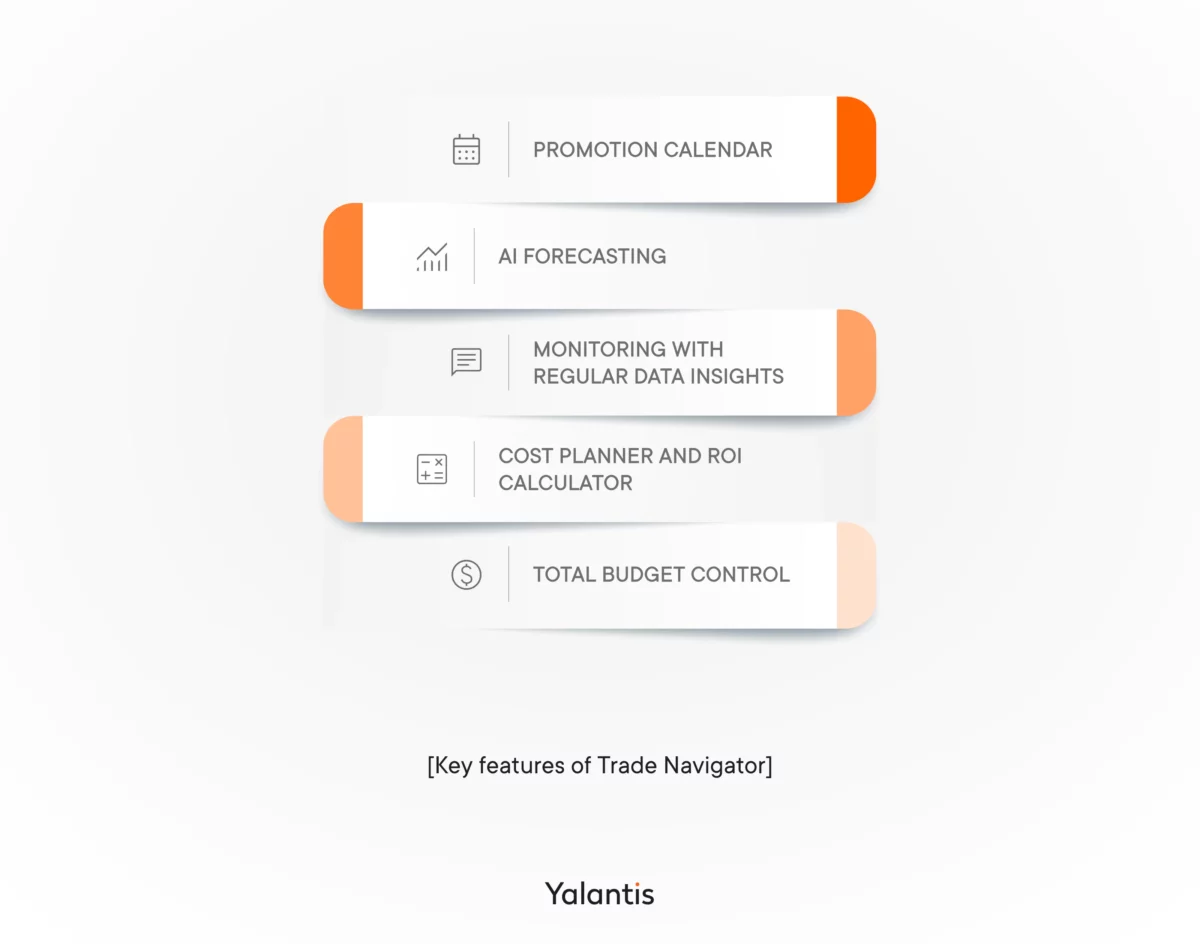
See how your business can run winning promos by using Trade Navigator:
#1. Promotional calendar: Gain a clear overview of all ongoing marketing campaigns to avoid scheduling conflicts with key accounts
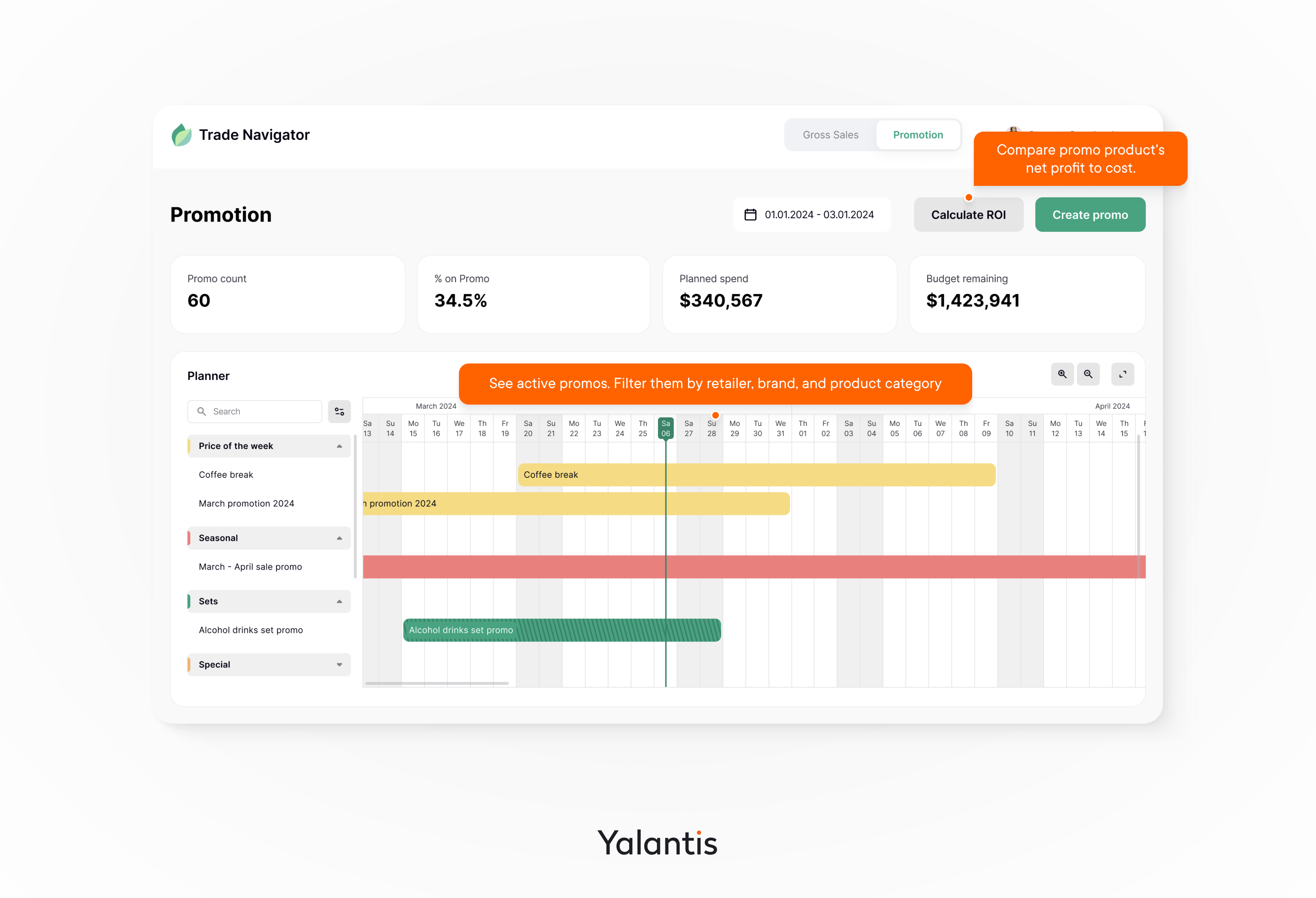
- Unified view: After creating a promotion, it’s added to a timeline where you can see all active promotions by category, product, and retailer.
- Maximize opportunities: This clear overview ensures you capitalize on peak selling periods, avoiding missed opportunities and conflicts, leading to higher revenue potential.
#2. AI forecasting: Build winning promos based on thoroughly analyzed historical data, identified trends, and seasonal patterns
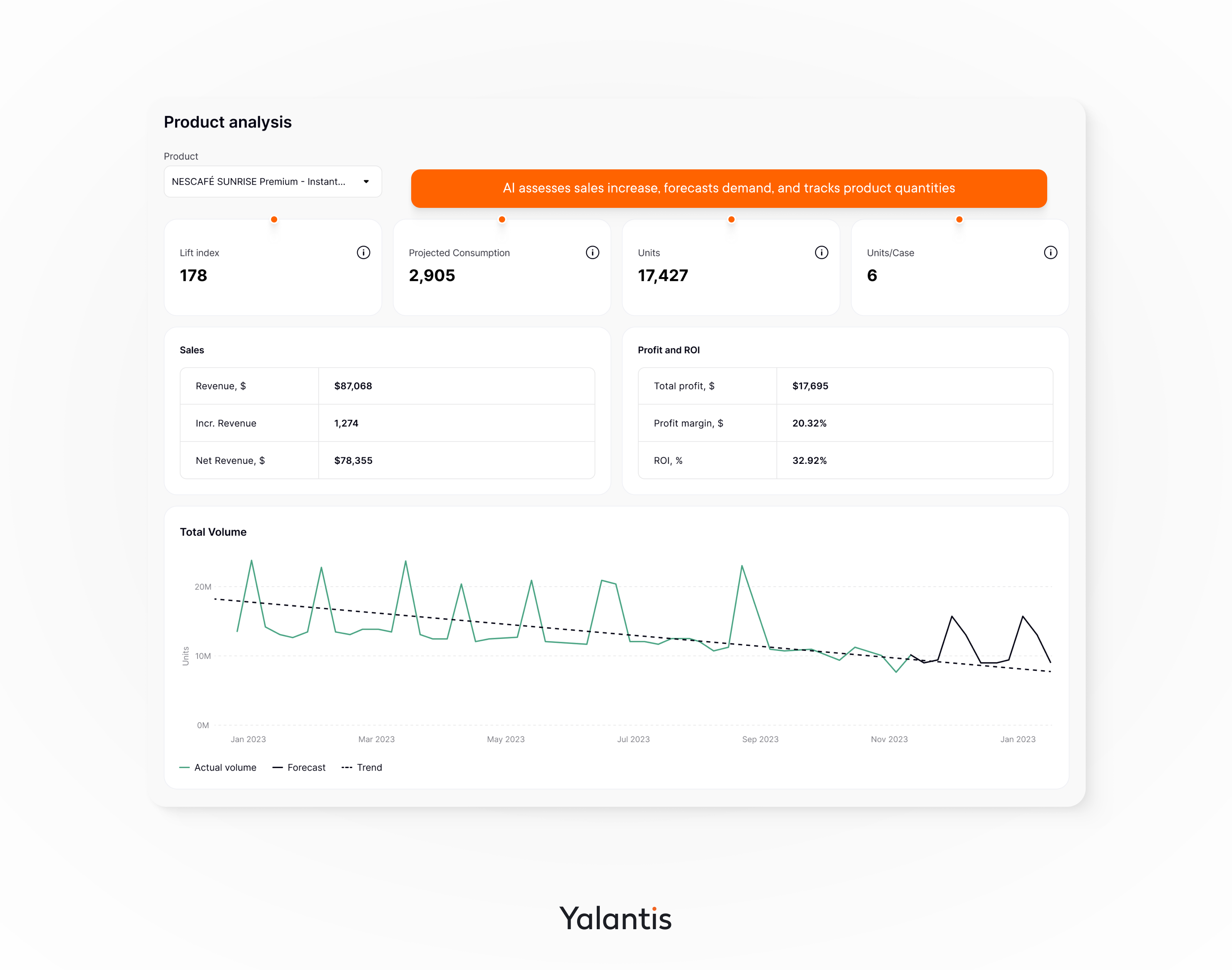
- Data-driven planning: Accurate sales lift and trade promotion ROI projections help you greenlight high-impact promotions and avoid ineffective ones. Smarter promotion planning — better topline results.
- Cut down on manual work: Instead of spending time and risking errors by manually entering data and creating reports, your account managers can use Trade Navigator’s AI forecasting to do these tasks in minutes with just a few clicks.
#3. Monitoring with regular insights from data visualization: Optimize your ongoing and future campaigns based on regularly updated data dashboards
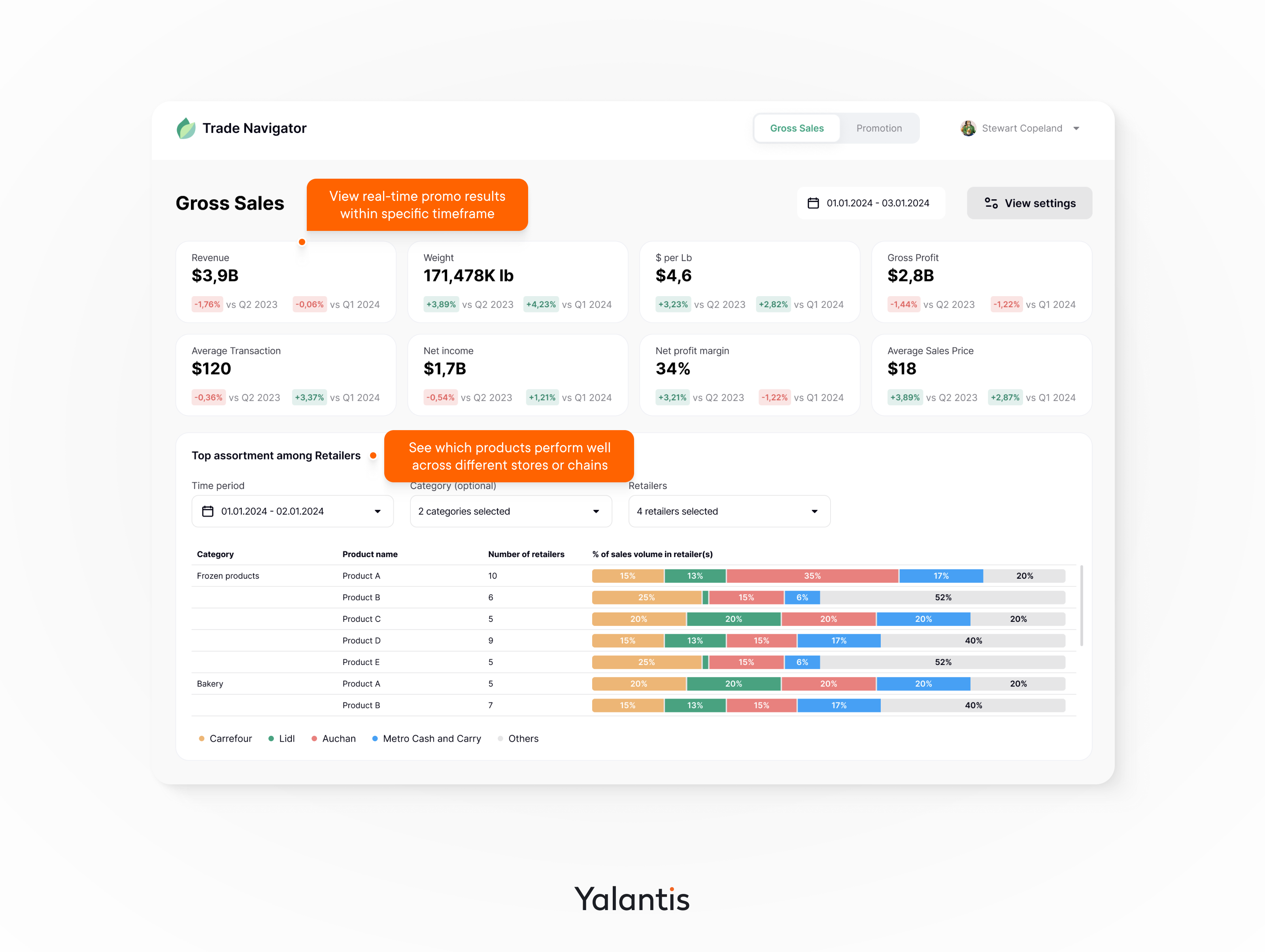
- Real-time visibility: Track promotion performance and key performance indicators (KPIs) as data is updated to make data-driven adjustments quickly. If a promo underperforms, you can course-correct before draining your budget. Or you can repeat your hits.
- Increase efficiency and cross-department visibility: Instead of spending hours on data collection and reporting, your marketing managers can focus on analyzing data and developing effective promotional strategies. Additionally, different departments can track relevant information, fostering collaboration and alignment.
#4. Cost planner and ROI calculator: Get a full control over your spendings upfront
- Strategic planning: Model projected promotion costs and returns accurately to align promotions with overall revenue targets.
- Avoid guesswork: A built-in budgeting tool replaces error-prone spreadsheets, allowing for precise financial planning from the start.
#5. Total budget control: Track your promo budget to identify stopping points or adjust plans for promotional activities based on remaining funds and immediate business needs.
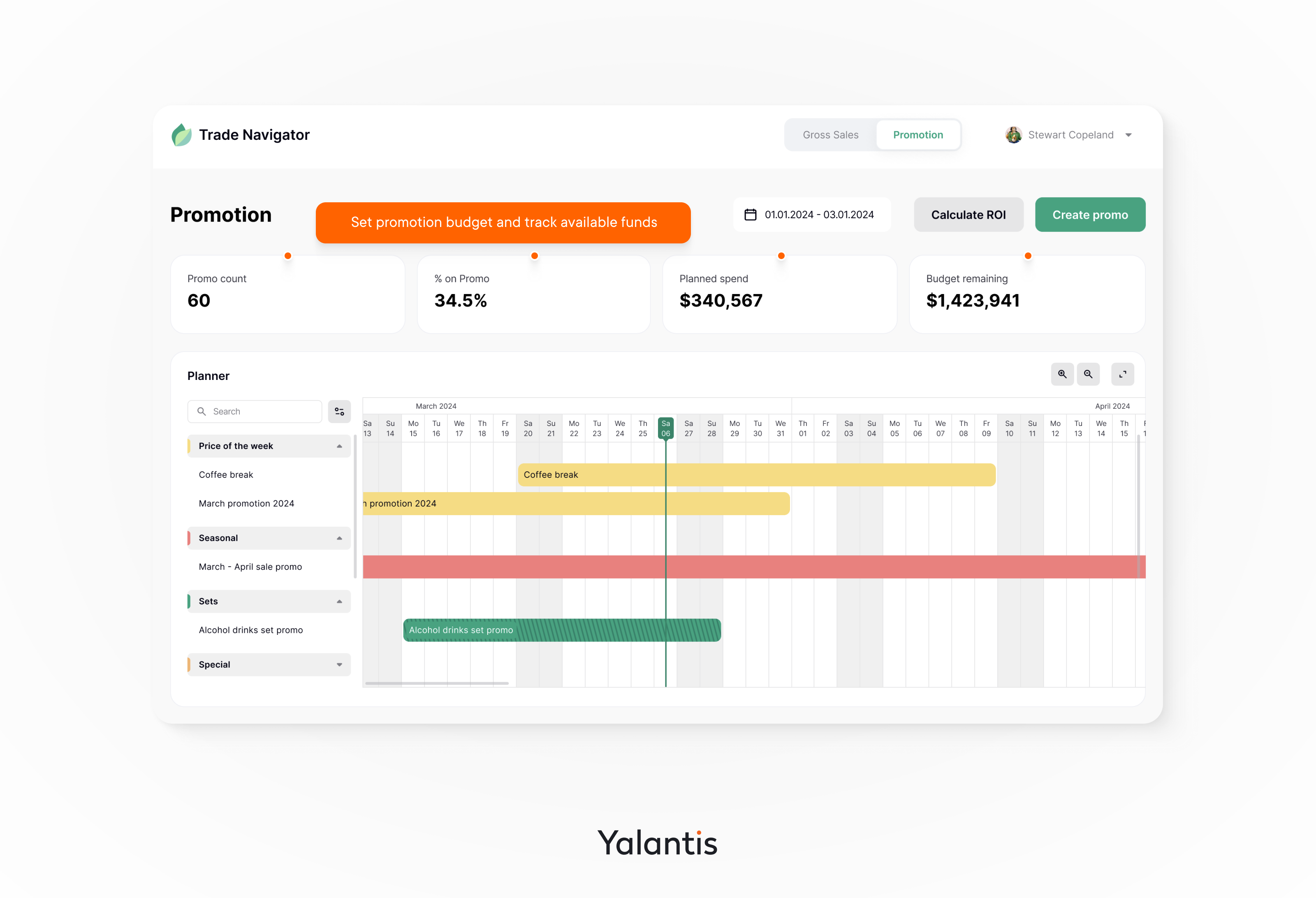
- Centralized tracking: Monitor promotion spending to prevent budget overruns.
- Financial flexibility: Cut off unsuccessful promotions early and reallocate funds to more effective initiatives, promoting profitable outcomes.
Trade promotion management doesn’t have to be complex — see its powerful and user-friendly side with Trade Navigator.
See prototypeThe outcome? More efficient sales and better use of your promotional money.
With Trade Navigator, you can improve the visibility, efficiency, and ROI of your promotions. What does this mean in real life? Better visibility into promotion performance helps you quickly adjust to what works and stop what doesn’t. AI-driven forecasting based on historical data patterns allows you to plan higher-impact, data-backed promotions from the start. And strong financial controls prevent budget issues like overspending.
Think these features could benefit your business? Consider implementing Trade Navigator. You’ll have fewer things to worry about and more control, at the same time. That said, let’s quickly walk through different scenarios for implementing this solution.
Is your business on the list?
Among many trade promotion management solutions, Trade Navigator fits different business uses cases
Want to get your TPM capabilities up and running? Great call — maximizing the impact of your promotions can only help. You may worry about implementation headaches, though, and that’s understandable. Introducing a new system often requires significant changes to existing processes, extensive user training, data migration efforts, and more — all that “fun” stuff you can’t wait to dive into, right?
That’s why the Yalantis team streamlined the integration process of its solution, offering two cooperation models (more on them in a bit) to make our Trade Navigator suitable for different business needs.
Look through the following scenarios—are any of these relevant to you?
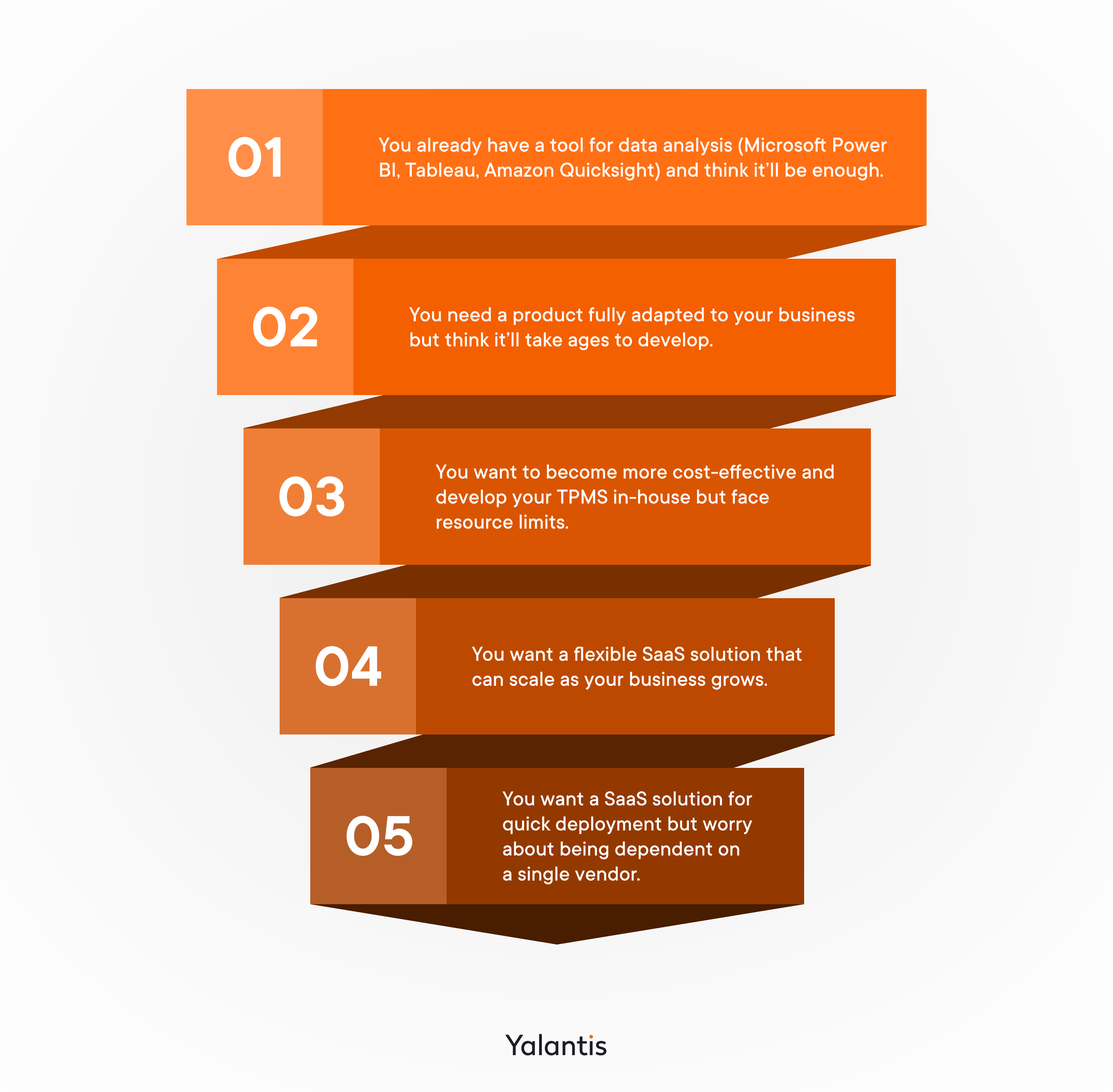
How Trade Navigator can fit your unique business case
#1. You already have a tool for data analysis (Microsoft Power BI, Tableau, Amazon Quicksight). Won’t it be enough? The Yalantis data team can deploy Trade Navigator in any data analysis tool you use. This way, your business’s historical data and reports won’t go anywhere — they’re integrated into your existing infrastructure. Trade Navigator enhances those BI tools with purpose-built TPM analytics, workflows, forecasting models, and more.
#2. You need a product fully adapted to your business but think it’ll take ages to develop. Not really — you can get such a product in up to one month. Trade Navigator is a complete product with a ready-to-use interface. To start using it, a data engineer will clean and set up your data. This integration phase lasts up to a month, and we’ll launch a product fully adapted to your business. Intellectual property remains with you, making it your in-house system. A data engineer will be needed to support these pipelines, either in-house or with our help.
#3. You want to become more cost-effective and develop your TPMS in-house but face resource limits. Trade Navigator is a complete product with a ready-to-use interface. All that’s left is for Yalantis data engineering services to integrate your business data (integration phase lasts up to a month). After that, Trade Navigator becomes your in-house system and intellectual property.
#4. You want a flexible SaaS solution that can grow with your business. As your company scales and the number of software users increases, the cost usually goes up. But with Trade Navigator, you’ll spend only on infrastructure, keeping costs manageable.
#5. You want a SaaS solution for quick deployment but worry about being dependent on a single vendor. Worrying about vendor dependency is reasonable: if your SaaS changes functionality or exits the market, you could be left without a solution. Things are different with Trade Navigator. It integrates with your existing systems and infrastructure, giving you control over your data and reducing dependency on a single vendor. This ensures you have flexibility and continuity even if the market changes.
But how can one product address all these use cases? Yalantis built Trade Navigator as the trade promotion management software that would benefit different businesses. This is a flexible solution you can integrate using one of two cooperation models.
Start using Trade Navigator on flexible terms: Choose a fitting cooperation model
You can start using Trade Navigator either with:
- perpetual license — paying only for the deployment
- cloud subscription — signing up for an annual product license and paying a monthly fee
Your business use case defines the most fitting cooperation model:
- You already have a tool for data analysis (Microsoft Power BI, Tableau, Amazon Quicksight) — perpetual license/cloud subscription
- You need a product fully adapted to your business but think it’ll take ages to develop — perpetual license
- You want to become more cost-effective and develop your TPMS in-house but face resource limits — perpetual license
- You want a flexible SaaS solution that can grow with your business — cloud subscription
- You want a SaaS solution for quick deployment but worry about being dependent on a single vendor — cloud subscription
#1: Perpetual license (Pay once, own forever)
You pay only for deployment, not for the product:
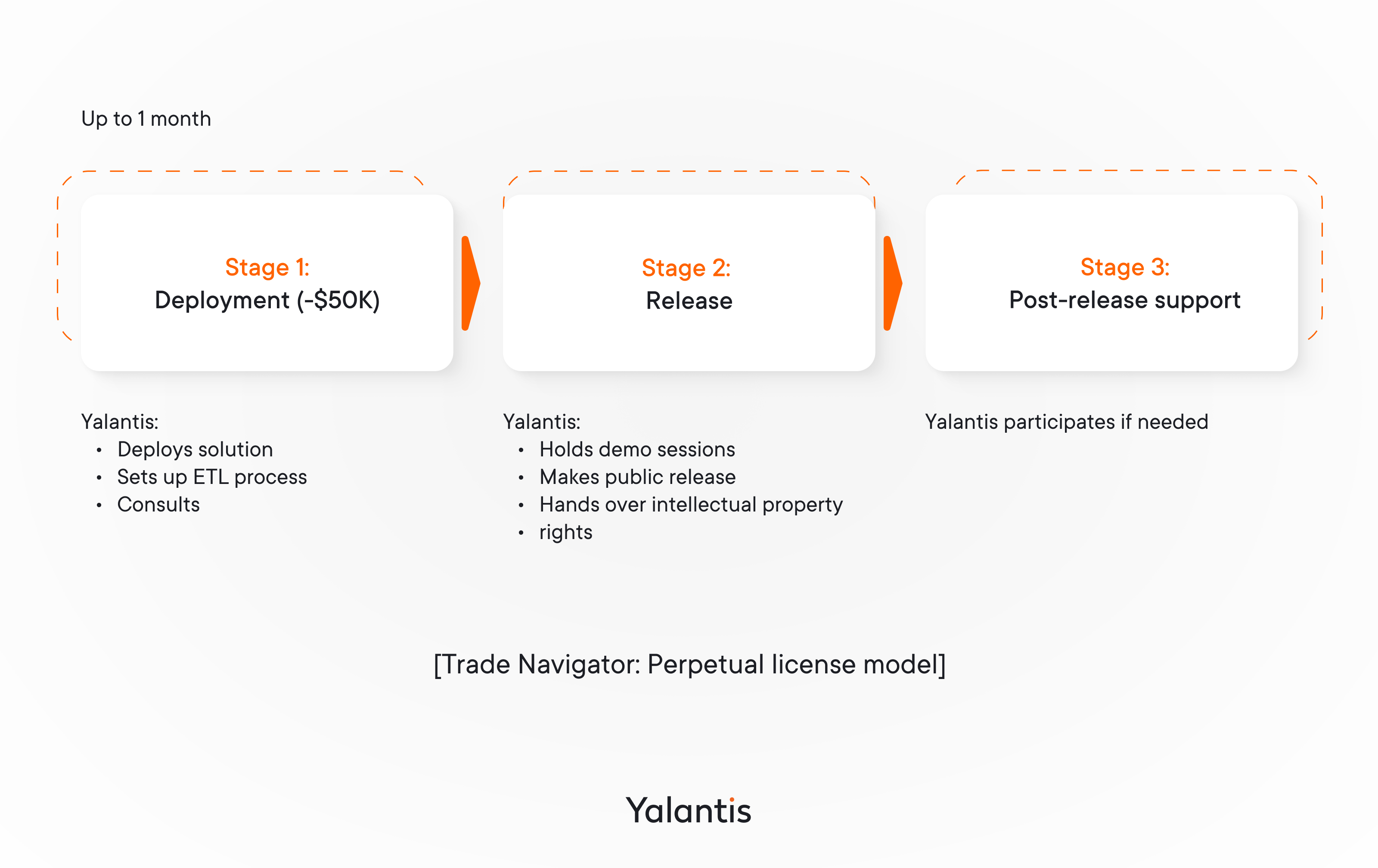
#2: Cloud subscription (Pay monthly, access included)
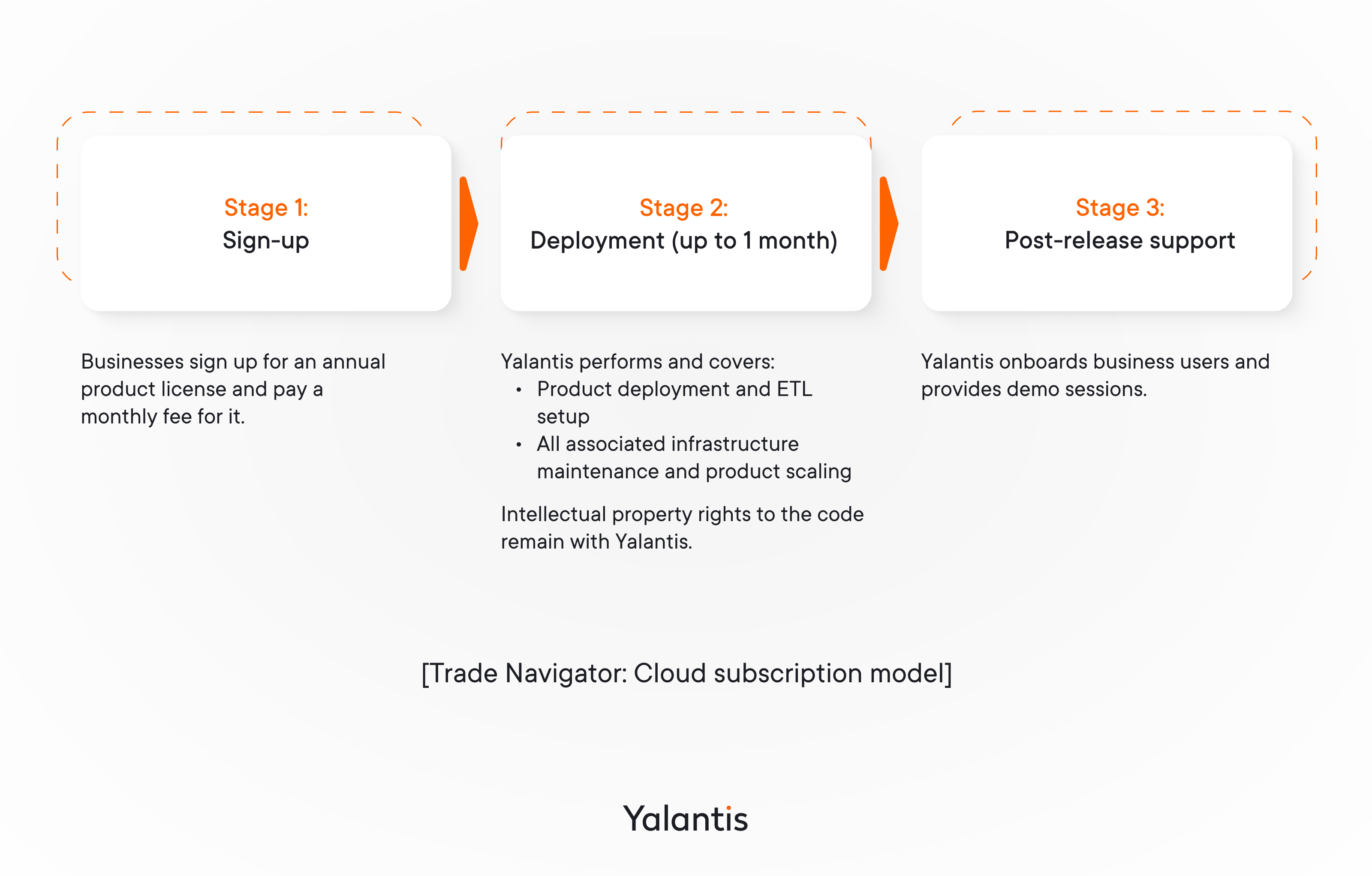
FAQ
What is trade promotion management?
Trade promotion management (TPM) is the process of planning, executing, and analyzing promotions and deals with retailers and distributors to drive sales of products. It involves managing the entire promotion lifecycle, including planning, forecasting, execution, tracking performance, evaluating ROI, and ensuring compliance. This is possible through trade promotion effectiveness tools like Trade Navigator. Learn more in this article.
What are key trade promotion management phases?
The key phases of trade promotion management process are:
- Planning — selecting promotions and forecasting results
- Execution — implementing promotional campaigns
- Trade promotion optimization — using data analysis to refine and improve current and future promotions and gain a competitive edge
Does Yalantis provide trade promotion management services?
Yes, Yalantis provides trade promotion management consulting and development through our product offering — trade promotion management software called Trade Navigator. It’s available via perpetual license or cloud subscription. Find out more in this article.
Rate this article
4.9/5.0
based on 15 reviews






